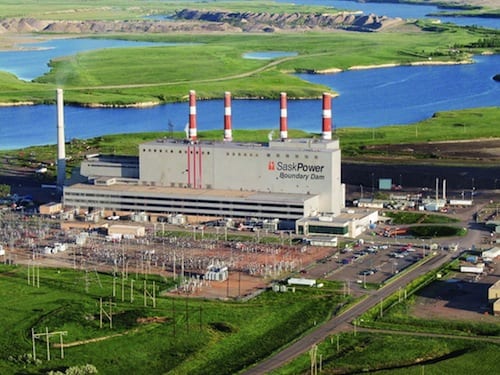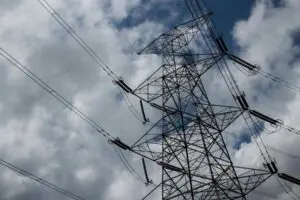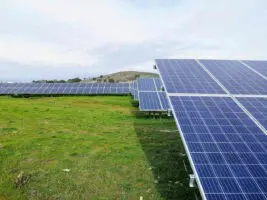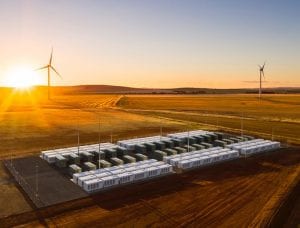As the UN’s global climate change conference looms and the political isolation of the coal industry grows, BHP Billiton has unveiled plans to spruik the Boundary Dam Carbon Capture and Storage (CCS) project in Canada as a ‘solution’ to climate change.
A little over a week ago BHP Billiton and SaskPower, the publicly-owned Saskatchewan utility with 1530 megawatts (MW) of mostly small old coal plants, announced they would establish a “global knowledge centre to help promote research and reduce the cost and risk associated with new CCS projects.”
The project will be centred on proselytising the ‘success’ of SaskPower’s Boundary Dam plant: the refurbishment of an old 140 MW lignite-fired unit at a cost of over C$1.4 billion which is touted as capturing 90 per cent of the plant’s carbon dioxide emissions. The carbon dioxide is then sold to Cenovus Energy which uses it to boost production from the declining Weyburn-Mildale oil project 66 kilometres from the Boundary Dam plant. In oil industry jargon, Weyburn-Mildale is an ‘Enhanced Oil Recovery’ (EOR) project.
BHP Billiton’s announcement, however, was vague on exactly what the project would do. “Specifics still need to be worked out,” SaskPower said in an email. According to BHP Billiton, SaskPower “does not have the necessary resources, systems and structures to manage the knowledge-base and information requests, to facilitate access and co-ordinate research.”
While BHP Billiton has tentatively agreed that “a multi-million dollar investment” in a project could span five years, the agreement has yet to be finalised.
A few days after BHP Billiton’s announcement Greg Evans, from the Minerals Council of Australia – the peak lobby group for the coal industry in Australia – proclaimed that the Boundary Dam project “is delivering affordable energy with a 90 per cent reduction in CO₂.”
Rubbery Figures
At the heart of hype about the Boundary Dam CCS project is a bundle of claims the coal industry and old-guard power generators are keen to perpetuate: that CCS plants reduce emissions compared to business as usual, that they provide cost-competitive power; and wider deployment is both inevitable and desirable.
SaskPower is fond of claiming that the Boundary Dam CCS project (which is also referred to as BD3) is the equivalent taking “250,000 cars off the road.” However, as the carbon dioxide is used to boost oil production at the Weyburn field, a full climate balance sheet requires accounting for the additional emissions from oil-field production and processing and the oil’s ultimate consumption.
So what is the real magnitude of the climate mitigation benefit, if any, of the Boundary Dam CCS plant?

SaskPower declined to provide an estimate, saying they only calculate the emissions reduction at the level of their own plant; and questions about additional emissions beyond there should be addressed to Cenovus Energy.
When BHP Billiton was asked what their assessment of the emissions reduction from Boundary Dam CCS project is, after allowing for Cenovus Energy’s additional emissions from the enhanced oil production, the company opted to dodge the question. “Technical questions on how SaskPower publicly accounts for emissions are best directed to SaskPower,” a company spokesperson said.
If SaskPower’s Boundary Dam CCS project really took 250,000 cars off the road at a cost of C$1.4 billion, surely it is reasonable to have an answer to how many Cenovus Energy’s Enhanced Oil Recovery project put back on?
The tally looks roughly like this: SaskPower says the revamped coal unit will generate 1.1 million tonnes of carbon dioxide emissions a year, with 100,000 tonnes (+25,000 cars worth) directly vented a year and the remainder diverted to the CCS plant. SaskPower use a figure of 4 tonnes of Co2 per year from a medium-sized car.
Saskatchewan financial analyst and wind advocate James Glennie noted in a detailed review of the CCS project that there is also the loss of about 300,000 tonnes a year of carbon dioxide (+75,000 cars worth) in Cenovus Energy’s processing of the Co2 and crude oil mix.
Glennie also notes that – each tonne of Co2 injected into the Cenovus Energy’s Weyburn-Mildale field is likely to produce an extra two to three barrels of oil which – using US Energy Information Administration data – will produce about 412 kilograms of Co2 per barrel when burnt. (That’s another 206,000 to 309,000 cars’ worth).
Even discounting these figures due to uncertainties about the exact volume sold to Cenovus and losses at the EOR project end, it seems clear that the climate mitigation benefit from the Boundary Dam CCS project is negligible, if any.
Does the bottom line matter?
How about the claims by both SaskPower and the Minerals Council of Australia that the Boundary Dam CCS project produces “affordable energy”?
This too is hotly contested. Glennie estimates the cost of the sequestered Co2 to be C$100 per tonne and the project likely to leave SaskPower consumers to carry a C$1 billion loss over the 30-year life of the plant. (It is worth noting that Glennie’s C$100 per tonne estimate for burying Boundary Dam’s carbon dioxide is about triple the cost of the carbon tax in Australia which BHP Billiton and others spent tens of millions overturning.)
The largest beneficiary of the project is Cenovus Energy. Another report, by the Canadian Centre for Policy Alternatives, reached similar conclusions.
The project has pushed SaskPower’s debt and interest costs up and exposed it to significant financial risks. In early 2014 SaskPower sought approval for a 15 per cent tariff increase over three years. While the figure was pared back by the Rate Review Panel and even further by the provincial government, financial pressure is building on the utility.
A recent report by the International Energy Agency’s Greenhouse Gas R&D Programme on the Boundary Dam project soberly cautioned (p. 22) that the by the time a power project had been built changing economic and technical conditions “can potentially make its choice look poor relative to newer information. Almost certainly, the comparative cost of various fuel sources will have changed. This proved to be the case for BD3.”
With coal with CCS costing the best part of double that of onshore wind and more than a gas-fired plant, SaskPower backed a financial loser.
Why is BHP Billiton even bothering with Boundary Dam?
Since BHP Billiton is a mining company, not a power utility, why is it even contemplating spending millions of shareholders’ funds promoting CCS? There are three plausible reasons.
Firstly, while BHP has offloaded the its South African, US and lower-value Australian thermal coal mines into the new South 32 company which it sold off in May this year – it still is a big coal producer.
In its latest financial report the company suggested that in the coming financial year it would produce 80 million tonnes, with half comprising power station coal and the rest metallurgical coal predominantly for steel mills.
Secondly, a few million dollars is far, far cheaper than actually building just about any part of a real CCS plant.
While Fiona Wild, BHP Billiton’s Vice-President of Environment & Climate Change, proclaimed earlier this year that the company had spent “almost half-a-billion dollars on low emissions technology research, development and deployment” since 2007, precious little seems to have been on CCS.
In none of BHP Billiton’s annual reports since 2007 does the company disclose to shareholders that it has been spending money on CCS projects. The closest it came was a passing mention in its 2014 annual report that it was a member of various groups which primarily advocated taxpayers subsidise CCS projects. Asked how much the company actually spent on CCS in the last financial year, BHP Billiton provided no detail beyond referring to the fact that it pursues a range of energy efficiency measures.
Finally, for a company like BHP Billiton, spending a few million dollars on a CCS ‘knowledge centre’ is a cheap political insurance policy. Late last week Mike Henry, BHP Billiton’s coal head said that “in the lead up to the Paris … [climate negotiations conference] discussions at the end of the year the focus is on our industry.”
Clearly BHP Billiton is hoping that hyping a yet-to-be finalised MOU about a project designed to hype CCS will be enough to get it taken it seriously when its lobbyists descend on Paris with the increasingly lonely task of defending coal.
While a few million dollars over five years may sound like a serious investment, it is chump change for a resources company which turned over US$45 billion last year. A single new haul truck for a coal mine would cost more.
When announcing the MOU with SaskPower, a BHP Billiton spokesperson said the project was “firmly aligned with BHP Billiton’s climate change position.”
That BHP Billiton wants to trumpet as a success story SaskPower’s obsession with building a CCS coal plant when lower cost and lower emissions options are available is a telling indication that the company views its climate policy through a coal-fogged lens.
That BHP Billiton thinks it is a good idea to promote building more projects like the Boundary Dam CCS plant is testimony to the pre-Paris climate talks panic that is gripping the coal industry.
Bob Burton is the Editor of CoalWire, a weekly bulletin on global coal industry developments. (You can sign up for it here.) Bob Burton’s Twitter feed is here.









